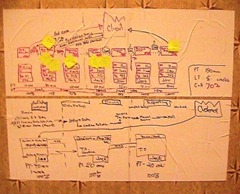Yesterday, I had the pleasure of attending the Lean Enterprise Workshop: Value-Stream Mapping for the Office and Service. The workshop description:
This interactive workshop demonstrates how to apply value-stream mapping, a fundamental and critical tool, to address what many companies find difficult to do: making a fundamental change in business processes such as administrative, professional, and transactional activities. You will see how the key elements of lean thinking and value-stream mapping apply to such activities by identifying key processes to tackle, drawing an accurate current-state map of each process, applying lean principles to envision a leaner future-state for each process, and implementing the future-state in a way that can be sustained.
Jim Luckman of Lean Transformations Group was the facilitator, (Recent B901 Podcast Participant) and did a very good job of combining instruction, case studies and interactivity. LEI is a stickler for interactivity in their workshops and it is a well learned lesson for me. I struggle creating webinars that have interactivity and always wonder if the people on the other side are sleeping or how much other things they are getting done during the webinar ;). I have made a commitment to work towards that goal and more so than just the standard survey questions.
 It is always great to see others present and to receive fresh material. I have spent a great deal of time in the past year constructing Value Stream Mapping processes for marketing. In doing so, I have ventured into many uncharted areas and as a result have taken certain liberties in my mapping processes. In the workshop, I got back on track and learned or reinforced 2 particular areas that I felt are important to the marketing process.
It is always great to see others present and to receive fresh material. I have spent a great deal of time in the past year constructing Value Stream Mapping processes for marketing. In doing so, I have ventured into many uncharted areas and as a result have taken certain liberties in my mapping processes. In the workshop, I got back on track and learned or reinforced 2 particular areas that I felt are important to the marketing process.
1. Chunking: When you start creating a Future State Map it is wise to step back and take a more empirical view of the process looking for major outputs or changes in skill requirements. Dividing the Value stream Map in this fashion allows you develop chunks or groupings,. This allows the divided Value Stream to be scrutinized and more importantly better define your customer requirement, customer being the next recipient in the Value Stream. It was even challenging to define who that customer is and what the requirements for that handoff are. It reminded me of how we have been breaking down the Kanban boards and defining the endpoints and the queues. The methodology was a little different but the outcomes were very similar.
2. Heuristic/Transactional: Since this workshop was based on creating a Value stream Map for the Office and Service sector we spent time on the differences that were created in this sector versus manufacturing. I have to admit I struggle with mapping many marketing value streams and this little tip though simple made a great deal of sense to me and solved my problem. Most of my problems are a result of combining the Heuristic section of marketing to the Transactional side. The lesson to split the value stream at this point and create 2 separate Value Stream Maps paid for the workshop. It was like not seeing the forest because of the trees. I even feel kind of stupid even saying it but when I review past struggles the majority of them were exactly in this area. On the other hand, the ones that I had little struggle with were maps that naturally divided that area on their own.
I am returning tomorrow to the Lean Problem Solving Workshop facilitated by Tracey Richardson, another B901 Podcast Participant.
Related Posts:
Value Stream Mapping
Current State Map – Where are You?
Applying Value Stream Concepts eBook
Find a Beginning and Endpoint when starting a Kanban
Problem Solving really the Core of Lean Implementation
Lean Problem Solving – eBook

Comments are closed.